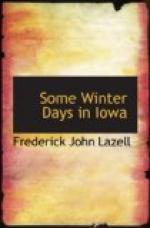* * * * *
By and by a snowflake falls, then a few others, soft as the spray of the thistle in the early days of October. Gently as the fairy balloons of the dandelion they float through the air and rest upon the withered leaves of the white oaks. Soon they come faster, and now the forest-crowned ridge half a mile away which was in plain sight a minute ago is screened from view by the fast falling white curtain.
“He giveth snow like wool.” Very beautiful is this snow as it softens the rugged, corky limbs of the mossy cup oaks. It is not like the hard, granular snow which stung your face like sand when you were out in the storm a month ago, when the trumpets of the sky were doing a fanfare, the wind raged from the northwest, the top of a tall black cherry snapped like a shipmast and crashed through the forest rigging to the white deck below, while the gnarled limbs of the big elms looked like the muscles of giants wrestling with the storm king. This storm to-day is not “announced by all the trumpets of the sky.” It comes softly as the breath of morning on a May meadow. It silences every sound and curtains you into a rare studio where you may admire its own exceeding beauty. There have not been so many beautiful snow crystals in any storm of the winter. You may see half a dozen different varieties on your coat sleeve with the naked eye, and you pull out a strong lens the better to observe the exceeding beauty of these six pointed stars. They are among Nature’s most exquisite forms, and they are shown in bewildering variety. The molecules of snow arrange themselves in crystals of the hexagonal system, every angle exactly sixty degrees. The white color of the snow is caused by a combination of the prismatic colors of these snow crystals. Some of them are regular hexagons, with six straight sides; others are like a wheel with six spokes, with jewels clinging to each spoke. Many men have spent a lifetime in the study of these fairy forms. W. A. Bentley, of the United States weather bureau, after twenty years of faithful work, has more than a thousand photographs of these crystals, no two alike. Every storm yields him a new set of pictures.
* * * * *
For a little while the snow grows damp and the flakes grow larger, making downy blankets for the babes in the woods—the hepaticas, the mosses, the ferns. The catkins of the hazelbrush are edged with white. The slender stems of the meadow-sweet begin to droop beneath the weight of the snow. The delicate yellow pointed buds of the wild gooseberry look like topaz gems in a setting of white pearl. The snow falls faster and the wood becomes a ghost world. The dull red torches of the smooth sumac are extinguished. The fine, delicate spray of the hop hornbeam is a fairy net whose every mesh is fringed with immaculate beauty. The little clusters of fine twigs here and there in the hackberry grow into spheres of fleecy fruit. The snow sticks to the tree trunks and makes a compass out of every one, a more accurate compass than the big radical leaves of the rosin weed in the early fall.




